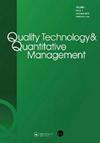最后失效模式下加速退化试验的最佳试验条件设置和样品分配
IF 3
2区 工程技术
Q3 ENGINEERING, INDUSTRIAL
Quality Technology and Quantitative Management
Pub Date : 2023-10-17
DOI:10.1080/16843703.2023.2269733
引用次数: 0
摘要
摘要加速降解试验(ADTs)被广泛应用于产品的失效,其失效定义为降解路径超过给定阈值时的首次通过时间(FPT)。然而,对于失效定义为最后退出时间(LET)的产品,很少有与ADT相关的研究。本文重点研究了LET失效模式下adt的最佳测试条件设置和样本分配方案。特别是采用了广泛采用的维纳过程模型和广义指数加速模型来描述产品的波动降解行为。通过最小化正常使用条件下平均失效时间的渐近方差,设计了总样本量和应力区域约束下的两级优化试验方案和三级妥协方案。以解析形式给出了最优方案,并证明了FPT失效模式下的最优方案与LET失效模式下的最优方案在某些情况下是等价的。最后,从加速机制等效的角度出发,基于ADT先验信息,提出了一种新的ADT应力水平上限选择方法。该方法是用实际应用的橡胶环说明。关键词:加速退化测试优化方案first-pass -timelast-exit-timedegradation mechanism等效致谢作者感谢编辑、副编辑和匿名审稿人提出的许多有见地的建议,这些建议大大提高了本文的质量。披露声明作者未报告潜在的利益冲突。这项工作由弹药和导弹支援技术实验室[2022SYSJ02]支持;可靠性与环境工程科学技术实验室[6142004210105]。作者简介董俊超,现任北京航空航天大学系统工程可靠性学院博士研究生。2014年获北京航空航天大学工学学士学位。主要研究方向为加速寿命试验和可靠性评估。马晓兵,2006年毕业于中国北京航空航天大学,获工程力学博士学位。现任北京航空航天大学可靠性与系统工程学院教授。他目前的研究兴趣包括可靠性数据分析、耐久性设计和系统寿命建模。王涵,2020年毕业于中国北京航空航天大学,获系统工程博士学位。现任北京航空航天大学可靠性与系统工程学院副教授。他的研究兴趣包括加速试验、随机退化建模和剩余使用寿命预测。刘玉杰,现任北京航空航天大学系统工程可靠性学院博士研究生。2021年获北京航空航天大学工学学士学位。主要研究方向为加速寿命试验和可靠性评估。赵宇,2005年毕业于中国北京航空航天大学,获系统工程博士学位。现任北京航空航天大学可靠性与系统工程学院教授,可靠性与环境工程技术重点实验室副主任。他目前的研究兴趣包括可靠性工程、质量管理和统计技术的应用。本文章由计算机程序翻译,如有差异,请以英文原文为准。
Optimum test condition setting and sample allocation for accelerated degradation tests under the last-exit-time failure mode
ABSTRACTAccelerated degradation tests (ADTs) have been widely adopted for products whose failure is defined as the first-passage-time (FPT) when the degradation path crosses a given threshold. However, for products whose failure is defined as the last-exit-time (LET), few studies related to ADT have been investigated. In this paper, we focus on designing an optimum test condition setting and sample allocation scheme for ADTs under the LET failure mode. In particular, the widely adopted Wiener process model and the generalized exponential acceleration model are used to describe the fluctuating degradation behaviors of products. By minimizing the asymptotic variance of mean-time-to-failure under the normal use condition, we design a two-level optimum test plan and a three-level compromise plan under the constraints of total sample size and stress region. The optimum plans are given in analytical forms, and we prove that the optimum plans under the FPT failure mode and LET failure mode are equivalent under some situations. Finally, a renewed selection method for the upper limit of the stress level in ADTs is proposed based on the prior ADT information from the perspective of accelerated mechanism equivalence. The proposed method is illustrated using a real-world application to rubber rings.KEYWORDS: Accelerated degradation testoptimization schemefirst-passage-timelast-exit-timedegradation mechanism equivalence AcknowledgementsThe authors are grateful to the editor, associate editor, and anonymous referees for many insightful suggestions that significantly improved the quality of this article.Disclosure statementNo potential conflict of interest was reported by the author(s).Additional informationFundingThis work was supported by the Ammunition & Missile Support Techniques Laboratory [2022SYSJ02]; Reliability and Environmental Engineering Science & Technology Laboratory [6142004210105].Notes on contributorsJunchao DongJunchao Dong is currently a PhD student with the School of Reliability of Systems Engineering, Beihang University, China. He received the BE degree from Beihang University in 2014. His research interests include accelerated life tests and reliability assessment.Xiaobing MaXiaobing Ma received a PhD degree in engineering mechanics from Beihang University, Beijing, China, in 2006. He is currently a professor with the School of Reliability and Systems Engineering, Beihang University. His current research interests include reliability data analysis, durability design, and system life modeling.Han WangHan Wang received a PhD degree in systems engineering from Beihang University, Beijing, China, in 2020. He is currently an associate professor with the School of Reliability and Systems Engineering, Beihang University. His research interests include accelerated tests, stochastic degradation modeling, and remaining useful life prediction.Yujie LiuYujie Liu is currently a PhD student with the School of Reliability of Systems Engineering, Beihang University, China. He received the BE degree from Beihang University in 2021. His research interests include accelerated life tests and reliability assessment.Yu ZhaoYu Zhao received a PhD degree in systems engineering from Beihang University, Beijing, China, in 2005. He is currently a professor with the School of Reliability and Systems Engineering, Beihang University, where he is also the Associate Director of the Key Laboratory on Reliability and Environmental Engineering Technology. His current research interests include reliability engineering, quality management, and application of statistics techniques.
求助全文
通过发布文献求助,成功后即可免费获取论文全文。
去求助
来源期刊

Quality Technology and Quantitative Management
ENGINEERING, INDUSTRIAL-OPERATIONS RESEARCH & MANAGEMENT SCIENCE
CiteScore
5.10
自引率
21.40%
发文量
47
审稿时长
>12 weeks
期刊介绍:
Quality Technology and Quantitative Management is an international refereed journal publishing original work in quality, reliability, queuing service systems, applied statistics (including methodology, data analysis, simulation), and their applications in business and industrial management. The journal publishes both theoretical and applied research articles using statistical methods or presenting new results, which solve or have the potential to solve real-world management problems.
 求助内容:
求助内容: 应助结果提醒方式:
应助结果提醒方式:


